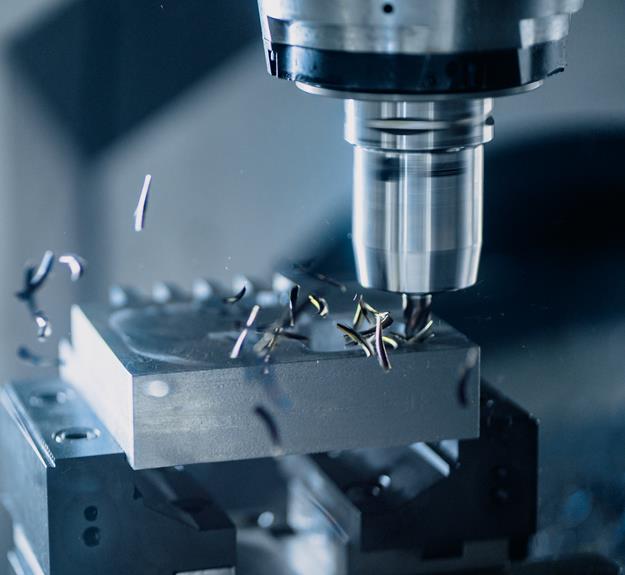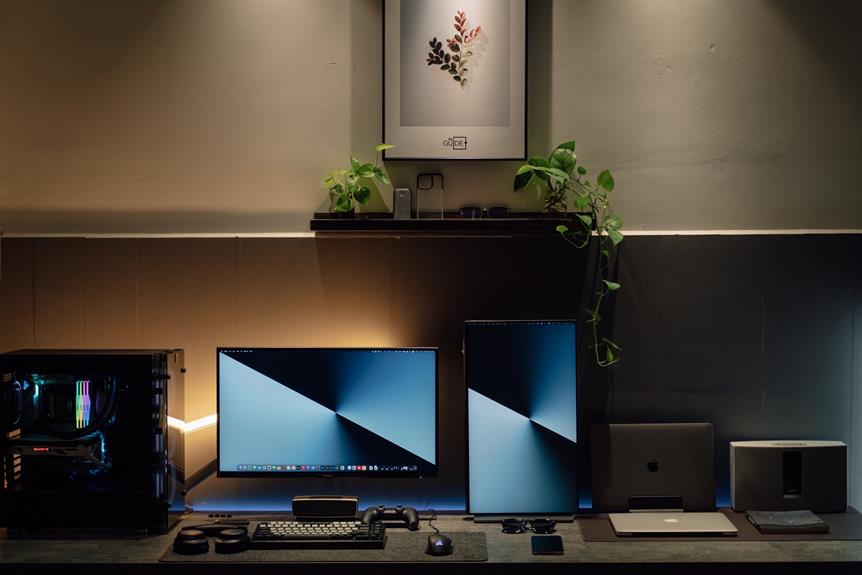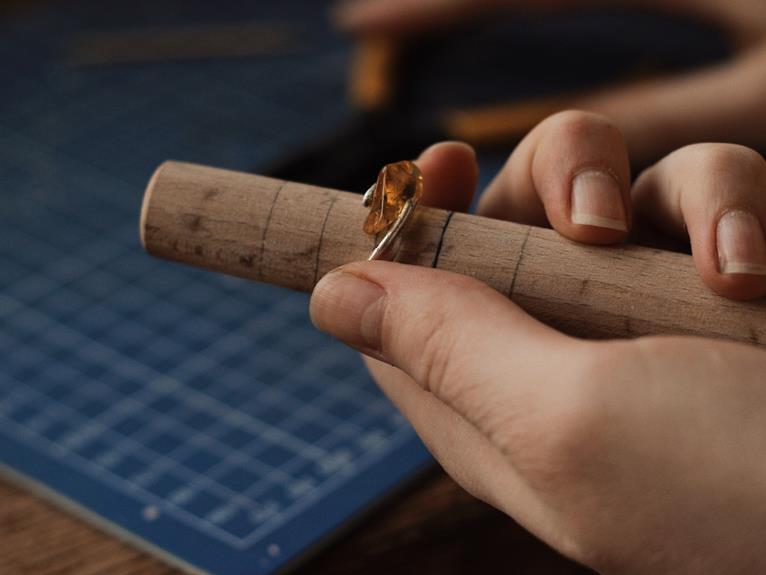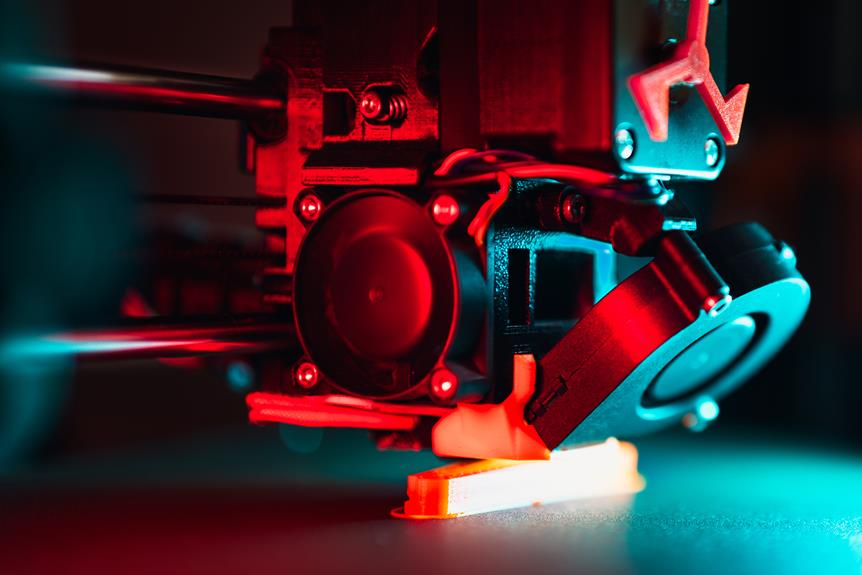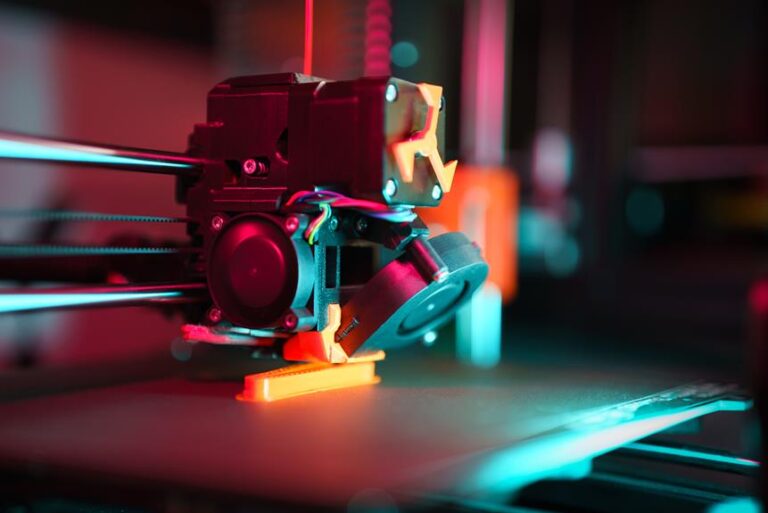MJF 3D Printers: Enhancing Manufacturing Efficiency With Multi-Jet Fusion
In today's rapidly evolving manufacturing landscape, the need for efficient and cost-effective production methods is paramount.
Enter MJF 3D printers, utilizing the cutting-edge technology of multi-jet fusion to enhance manufacturing efficiency.
This article explores the advantages of MJF in various industries, the materials compatible with this technology, and the potential it holds for faster prototyping and cost-effectiveness in production.
Join us as we delve into the world of MJF and its potential to revolutionize the manufacturing process.
Key Takeaways
- MJF 3D printing enables high-speed production, reducing manufacturing time and increasing overall efficiency.
- The use of MJF reduces production costs by minimizing material waste and allowing for the production of multiple parts simultaneously.
- MJF allows for intricate and complex designs to be printed with precision, providing manufacturers with greater design flexibility.
- The technology of MJF produces parts with excellent surface finish and dimensional accuracy, ensuring high-quality end products.
The Evolution of 3D Printing Technology
Over the past two decades, 3D printing technology has rapidly evolved, revolutionizing various industries and opening up new possibilities in manufacturing. One of the most significant advancements in this field is the development of Multi-Jet Fusion (MJF) printing.
MJF printing is a process that enables the rapid manufacturing of complex prototypes and end-use parts with exceptional precision and quality. Unlike traditional 3D printing methods, MJF printing utilizes a multi-jet system that deposits a binding agent and a fusing agent onto a powdered material bed. The binding agent selectively binds the particles together, while the fusing agent enhances the strength and durability of the printed object. This unique approach allows for faster printing speeds and the production of highly detailed and functional parts.
MJF printing offers numerous advantages for manufacturers. Firstly, it allows for the creation of complex geometries that are not possible with traditional manufacturing methods. This enables designers to push the boundaries of their creativity and produce innovative products. Secondly, MJF printing enables rapid manufacturing, significantly reducing lead times and allowing for on-demand production. This can greatly enhance supply chain efficiency and reduce inventory costs.
Understanding Multi-Jet Fusion 3D Printing
Multi-Jet Fusion 3D printing offers high-speed production capabilities, allowing for faster manufacturing processes compared to traditional methods. This technology utilizes multiple jets to simultaneously deposit materials and a fusing agent, resulting in efficient and precise prints.
High-Speed Production Capabilities
With its ability to rapidly fabricate complex geometries and intricate designs, Multi-Jet Fusion 3D printing revolutionizes high-speed production capabilities in the manufacturing industry. This innovative technology offers several advantages that set it apart from traditional manufacturing methods:
- Unmatched Speed: MJF 3D printers can produce parts at an incredibly fast rate, significantly reducing production time.
- High Accuracy: The precision of MJF allows for the creation of intricate details and complex structures with exceptional accuracy.
- Cost Efficiency: By eliminating the need for molds or tooling, MJF reduces production costs, making it a more cost-effective option.
- Versatility: MJF can work with a wide range of materials, including plastics, metals, and ceramics, enabling manufacturers to create diverse products.
Improving Manufacturing Processes
By providing unprecedented design freedom and reducing production constraints, Multi-Jet Fusion 3D printing revolutionizes manufacturing processes in an industry constantly seeking to enhance efficiency and productivity.
This technology allows manufacturers to create complex geometries and intricate designs that were previously impossible with traditional manufacturing methods.
With Multi-Jet Fusion, multiple parts can be printed simultaneously, reducing the need for assembly and minimizing production time.
The ability to print functional prototypes and end-use parts in a single process streamlines the manufacturing workflow and eliminates the need for multiple manufacturing steps.
Additionally, the use of advanced materials in Multi-Jet Fusion printing allows for the production of durable, high-quality parts that meet industry standards.
Advantages of MJF in Manufacturing Processes
As manufacturing processes continue to evolve, the advantages of incorporating MJF technology become increasingly evident. MJF offers several benefits that can significantly enhance manufacturing processes:
- High-speed production: MJF enables rapid printing of complex parts, reducing production time and increasing overall efficiency.
- Cost-effective: With its ability to produce multiple parts simultaneously, MJF reduces material waste and lowers production costs.
- Design freedom: MJF allows for intricate and intricate designs to be printed with precision, providing manufacturers with greater design flexibility.
- Improved part quality: MJF produces parts with excellent surface finish and dimensional accuracy, ensuring high-quality end products.
These advantages make MJF a valuable addition to manufacturing processes, empowering businesses to streamline production, reduce costs, and improve product quality.
As we delve deeper into exploring the materials compatible with MJF, it is important to understand the benefits they bring to the manufacturing industry.
Exploring the Materials Compatible With MJF
Many different materials can be used with MJF, and they provide manufacturers with a wide range of options for creating high-quality 3D printed parts.
MJF is compatible with a variety of thermoplastics, including nylon, polypropylene, and elastomers. These materials offer different mechanical properties and characteristics, allowing manufacturers to choose the most suitable material for their specific applications.
Nylon is one of the most commonly used materials with MJF due to its excellent strength, durability, and flexibility. It is suitable for a wide range of applications, including functional prototypes, end-use parts, and complex geometries.
Polypropylene, on the other hand, is known for its low density, chemical resistance, and excellent fatigue properties. It is often used in applications that require lightweight and durable parts.
Elastomers, such as TPU (Thermoplastic Polyurethane), are also compatible with MJF. These materials offer high elasticity, good impact resistance, and flexibility, making them ideal for applications that require rubber-like properties.
In addition to thermoplastics, MJF can also be used with ceramic materials. Ceramic parts produced using MJF exhibit excellent thermal and mechanical properties, making them suitable for applications in industries such as aerospace and automotive.
Applications of Multi-Jet Fusion in Various Industries
Utilizing its advanced capabilities, Multi-Jet Fusion enables manufacturers to revolutionize production processes and improve efficiency in various industries. Here are some of the applications of Multi-Jet Fusion that are making a significant impact:
- Aerospace: Multi-Jet Fusion is used to produce lightweight components with complex geometries, reducing the weight of aircraft and increasing fuel efficiency.
- Automotive: With Multi-Jet Fusion, car manufacturers can quickly prototype and produce custom parts, reducing lead times and costs associated with traditional manufacturing methods.
- Medical: Multi-Jet Fusion allows for the production of personalized medical devices and prosthetics, improving patient outcomes and enhancing quality of life.
- Consumer Goods: Multi-Jet Fusion is being used to create customized products, such as smartphone cases and household appliances, giving consumers the freedom to design and personalize their purchases.
These are just a few examples of how Multi-Jet Fusion is being applied across various industries to streamline manufacturing processes and bring innovative products to market.
In the next section, we will explore how Multi-Jet Fusion enhances design flexibility and complexity, further expanding its capabilities in the manufacturing world.
How MJF Enhances Design Flexibility and Complexity
MJF technology offers versatile design possibilities, allowing for the creation of complex geometries that were previously difficult or impossible to achieve with traditional manufacturing methods.
This enhanced design flexibility opens up new opportunities for product innovation and customization.
Additionally, MJF can enhance product performance by enabling the integration of functional features, such as lattice structures and internal channels, directly into the printed parts. This integration results in improved strength, weight reduction, and optimized functionality.
Versatile Design Possibilities
The implementation of MJF technology offers manufacturers unprecedented design freedom, allowing for the creation of intricate and complex structures. With MJF, manufacturers can now explore versatile design possibilities that were previously difficult to achieve. Here are some key ways MJF enhances design flexibility and complexity:
- Geometric Complexity: MJF enables the production of complex geometries, including intricate lattice structures and organic shapes.
- Consolidation: MJF allows for the consolidation of multiple components into a single, integrated part, reducing the need for assembly and enhancing efficiency.
- Internal Complexity: MJF can create parts with internal channels, voids, and cavities, enabling the production of functional components with complex internal structures.
- Texturing: MJF offers the ability to add textures, patterns, and surface finishes directly during the printing process, enhancing the aesthetic appeal of the final product.
With these capabilities, MJF empowers manufacturers to push the boundaries of design and create innovative products with enhanced functionality and visual appeal.
Complex Geometries Made Easy
Frequently overlooked in traditional manufacturing processes, complex geometries are easily achieved and enhanced through the utilization of MJF technology.
With MJF 3D printers, designers and manufacturers have the freedom to create intricate and intricate designs that were previously difficult or impossible to produce. The Multi-Jet Fusion process allows for the creation of complex shapes, intricate details, and intricate internal structures with ease.
This technology enables the production of parts with high levels of complexity, such as lattice structures, honeycomb patterns, and internal channels. MJF's layer-by-layer printing method ensures precise control over every aspect of the design, resulting in parts that are not only visually stunning but also highly functional.
The flexibility and complexity offered by MJF technology open up new possibilities for innovation and design freedom in manufacturing.
Enhancing Product Performance
One of the key advantages of MJF technology is its ability to enhance design flexibility and complexity, allowing for the creation of highly intricate and intricate parts. With MJF, manufacturers can achieve new levels of product performance by leveraging its unique capabilities.
Here are four ways in which MJF enhances design flexibility and complexity:
- Complex geometries: MJF enables the production of complex and intricate geometries that were previously difficult or impossible to manufacture using traditional methods.
- Lightweight structures: MJF allows for the creation of lightweight parts with internal lattice structures, reducing material usage while maintaining strength and functionality.
- Customization: MJF enables the production of highly customized parts, allowing manufacturers to tailor products to specific customer requirements.
- Consolidation of parts: With MJF, multiple components can be consolidated into a single part, reducing assembly time and improving overall product performance.
With these capabilities, MJF empowers manufacturers to push the boundaries of design and create products that deliver exceptional performance and functionality.
Achieving Faster Prototyping With MJF
How can MJF 3D printers enhance the speed of prototyping in the manufacturing industry?
MJF 3D printers offer a range of benefits that can significantly expedite the prototyping process. The Multi-Jet Fusion (MJF) technology allows for fast and efficient production of prototypes, reducing the overall time required to bring a product to market.
One key advantage of MJF is its ability to simultaneously print multiple parts, known as batch production. This means that multiple prototypes can be printed in a single build, saving valuable time and resources.
Additionally, MJF printers have a high build speed, allowing for rapid production of prototypes compared to traditional manufacturing methods.
Furthermore, MJF printers offer excellent resolution and accuracy, ensuring that the prototypes produced are of high quality and closely resemble the final product. This eliminates the need for multiple iterations and revisions, further reducing the time required for prototyping.
Moreover, the design flexibility provided by MJF technology enables complex geometries and intricate details to be accurately reproduced in the prototypes. This eliminates the need for additional post-processing or manual adjustments, saving both time and effort.
Cost-Effectiveness of Multi-Jet Fusion for Production
Although initial investment costs may be higher, the cost-effectiveness of Multi-Jet Fusion (MJF) technology for production is evident in its ability to reduce material waste, increase manufacturing efficiency, and minimize post-processing requirements.
- Reduced Material Waste: MJF technology allows for precise and accurate printing, resulting in minimal material wastage. This is in contrast to traditional manufacturing methods where excess material is often discarded.
- Increased Manufacturing Efficiency: MJF enables the production of multiple parts simultaneously, reducing production time and increasing overall efficiency. Additionally, the technology allows for the customization of parts, eliminating the need for additional tooling and setup costs.
- Minimized Post-Processing Requirements: With MJF, parts are printed with a smooth surface finish, reducing the need for post-processing such as sanding or polishing. This not only saves time but also reduces the labor and cost associated with finishing processes.
- Greater Design Freedom: MJF technology allows for the production of complex geometries that are difficult or impossible to achieve with traditional manufacturing methods. This opens up new possibilities for product design and innovation.
Overcoming Challenges in MJF Implementation
To successfully implement MJF technology, manufacturers must address the challenges associated with equipment maintenance and operator training. MJF 3D printers require regular maintenance to ensure optimal performance and prevent downtime. This includes cleaning and replacing print heads, calibrating the machine, and monitoring for any potential issues. Additionally, operators need to be trained on how to operate the 3D printer effectively and troubleshoot common problems that may arise during the printing process.
| Challenges | Solutions | Benefits |
|---|---|---|
| Equipment Maintenance | Regular cleaning and maintenance schedules. Replacement of worn-out parts. | Increased printer lifespan and consistent print quality. |
| Operator Training | Comprehensive training programs covering machine operation, troubleshooting, and preventive maintenance. | Improved operator efficiency and reduced risk of errors. |
| Cost of Implementation | Conducting cost-benefit analysis to determine the return on investment. Collaborating with a reliable MJF technology provider. | Accurate budgeting and financial planning. Increased production efficiency. |
Future Innovations and Potential of MJF Technology
The future innovations and potential of MJF technology can revolutionize the manufacturing industry. With its ability to produce highly detailed and functional parts at a faster rate, MJF technology offers several exciting possibilities for the future. Here are four key areas where MJF technology can make a significant impact:
- Increased customization: MJF allows for the production of complex and customized parts with ease, enabling manufacturers to create unique products tailored to individual customer needs.
- Reduced costs: By eliminating the need for expensive tooling and reducing material waste, MJF technology has the potential to lower production costs significantly.
- Improved sustainability: MJF technology is more environmentally friendly compared to traditional manufacturing methods, as it produces less waste and consumes less energy.
- Accelerated product development: The fast production speed of MJF technology allows for quick prototyping and iteration, enabling manufacturers to bring products to market faster.
With these advancements, MJF technology has the potential to disrupt and transform the manufacturing industry, providing greater flexibility, efficiency, and sustainability. As the technology continues to evolve, we can expect to see even more innovative applications and improvements in MJF 3D printing.
Frequently Asked Questions
How Much Does an MJF 3D Printer Cost?
The cost of an MJF 3D printer depends on various factors such as the model, features, and additional accessories. It is essential to consider the specific requirements and budget before determining the exact cost of an MJF 3D printer.
Are There Any Limitations to the Size of Objects That Can Be Printed Using Mjf?
The size of objects that can be printed using MJF 3D printers may be limited by the build volume of the printer. However, advancements in technology have allowed for larger build volumes, providing increased flexibility and capabilities for printing larger objects.
What Is the Average Lifespan of an MJF 3D Printer?
The average lifespan of an MJF 3D printer varies depending on usage, maintenance, and technological advancements. However, with proper care and regular servicing, an MJF printer can last anywhere from 3-5 years before requiring significant upgrades or replacements.
Can MJF 3D Printers Be Used to Print Objects With Multiple Colors?
Yes, MJF 3D printers are capable of printing objects with multiple colors. The multi-jet fusion technology allows for precise and efficient color deposition, enabling the creation of vibrant and complex multi-colored prints.
Are There Any Specific Safety Guidelines or Precautions That Need to Be Followed When Using MJF Technology?
When using MJF technology, it is important to follow specific safety guidelines and precautions. These may include wearing appropriate protective gear, ensuring proper ventilation in the printing area, and adhering to manufacturer's instructions for safe operation.
Conclusion
In conclusion, multi-jet fusion (MJF) 3D printers have revolutionized the manufacturing industry by enhancing efficiency and reducing costs. With its ability to quickly produce high-quality prototypes and a wide range of compatible materials, MJF has found applications in various industries.
Despite challenges in implementation, the future holds great potential for further innovations in MJF technology. Like a well-oiled machine, MJF has streamlined manufacturing processes and paved the way for a more cost-effective and efficient future.
